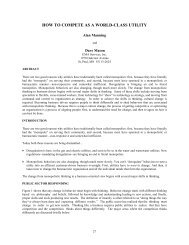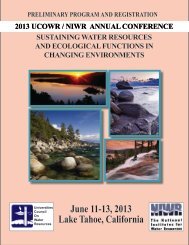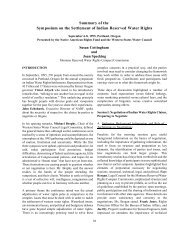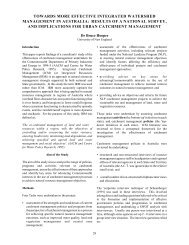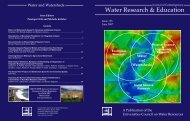92Davis <strong>and</strong> Threlfallby regional <strong>and</strong> district planners <strong>and</strong> resourceconsents processors, (b) limited Maori politicalrepresentation <strong>and</strong> active roles in planningdepartments in regional <strong>and</strong> local governments,(c) lack <strong>of</strong> ability to formulate information aboutthe Maori perspective in a manner that can beconsidered within the existing legal framework,(d) lack <strong>of</strong> coherent advocacy on the part <strong>of</strong> someMaori groups, <strong>and</strong> (e) limited economic resourcesfor Maori participation (Mutu 2002, Tunks 2002,Tipa 2006). Others contend that this is also dueto lack <strong>of</strong> true partnership by the “Crown” calledfor by the treaty <strong>and</strong> section 8 <strong>of</strong> the ResourceManagement Act, for example. Consultation isundertaken with the Maori as stakeholders ratherthan “partners” or “co-managers,” or in the case<strong>of</strong> rightful “owners <strong>of</strong> water” (Tunks 2002, Turia2006).At the local decision-making level that is,regional <strong>and</strong> local (district or city) councils,development <strong>of</strong> practical tools are underway tohelp incorporate Maori cultural issues formally intodecision-making on terms that local governmentcan more readily consider. A Cultural Health Indexfor streams <strong>and</strong> rivers was devised. In addition, aCultural Opportunity Matrix is under developmentto enable the Maori to participate in helpingidentify preferred flow regimes for waterways <strong>of</strong>significance (Tipa 2006, Tipa <strong>and</strong> Teirney 2006a,2006b).Thus a framework does exist to address Maoriissues in New Zeal<strong>and</strong>. A breach still existsregarding “Crown” responsibilities under the Treaty<strong>of</strong> Waitangi <strong>and</strong> the Maori role in ownership <strong>and</strong>management <strong>of</strong> water <strong>and</strong> other resources. Stepsare being taken to better incorporate the Maoriperspective <strong>and</strong> role in resource management.Public ConsultationSignificant public consultation <strong>and</strong> stakeholderinput forms the cornerstone <strong>of</strong> existing legislation.For example, local councils are currentlypresenting Long Term Council Community Plansto constituents (Government <strong>of</strong> New Zeal<strong>and</strong>2004). The Long Term Council Community Plancouches investment in water infrastructure <strong>and</strong>the environment for instance, alongside othergovernment services like libraries <strong>and</strong> footpaths.Long Term Council Community Plan feedbackwas completed in mid-2006 <strong>and</strong> is being incorporatedinto local government programs, helping set budgetenvelopes <strong>and</strong> allocation among various services.Furthermore, development <strong>of</strong> regional policystatements, regional plans, <strong>and</strong> district plansinvolve significant public input. Generally, focusgroups <strong>and</strong> public working groups are formed toparticipate in formulation <strong>of</strong> the statements <strong>and</strong>plans. Once draft statements or plans are published,a period exists for the public <strong>and</strong> interested partiesto comment <strong>and</strong>/or protest particular aspects.Objections are reviewed <strong>and</strong>, where possible,modifications are made prior to publication <strong>of</strong>final statements or plans. Various methods areused to broach objections, including facilitatedpublic meetings, direct negotiation, arbitration,<strong>and</strong> mediation. A last resort is referral to a specialEnvironment Court (Somerville 2004). For issuesreaching the Environment Court, final resolutionmay take many years.Resource consents such as water right permits,granted under the Resource Management Act byregional <strong>and</strong> district councils, also involve publicparticipation <strong>and</strong> review (R<strong>and</strong>erson 1997, Harris2004, Government <strong>of</strong> New Zeal<strong>and</strong> 2005). Theconsents can involve objections <strong>and</strong> similarfacilitated dispute resolution techniques.Financing IWRMFinancing <strong>of</strong> IWRM activities reflects acombination <strong>of</strong> resource consent user charges,general regional <strong>and</strong> local council rates, <strong>and</strong>national initiatives, which differ from regionto region <strong>and</strong> local council to local council. Inthe Auckl<strong>and</strong> Region, activities associated withIWRM are funded by rates levied by the differentlocal councils (seven within the region) <strong>and</strong> by theAuckl<strong>and</strong> Regional Council. Large rate increaseshave occurred in recent years to fund largeinfrastructure projects <strong>and</strong> differed investment.The increases have been met with significant ratepayer opposition, although in the end these rates arepaid. In the Otago Region, rates are supplementedby Ports <strong>of</strong> Otago revenue <strong>and</strong> therefore reduce thecontributions required by rate payers.Wet Weather Quality Management in theAuckl<strong>and</strong> RegionThe Auckl<strong>and</strong> Region lies on the North Isl<strong>and</strong>UCOWRJOURNAL OF CONTEMPORARY WATER RESEARCH & EDUCATION
IWRM in New Zeal<strong>and</strong>: Legislative Framework <strong>and</strong> Implementation93<strong>and</strong> is defined by the political boundaries <strong>of</strong> theAuckl<strong>and</strong> Regional Council. It is comprised <strong>of</strong>seven district <strong>and</strong> city councils: Rodney District,North Shore City, Auckl<strong>and</strong> City, Waitakere City,Manukau City, Papakura District, <strong>and</strong> FranklinDistrict. The Auckl<strong>and</strong> Region <strong>and</strong> Auckl<strong>and</strong> Cityin particular, is the fastest growing populationcenter in the country. Auckl<strong>and</strong> City, occupyingan isthmus between the Waitemata <strong>and</strong> ManukauHarbors, accounts for 32 per cent <strong>of</strong> the region’spopulation. Greater Auckl<strong>and</strong> comprised <strong>of</strong>Auckl<strong>and</strong> City together with Manukau City (24per cent), North Shore City (16 per cent) <strong>and</strong>Waitakere City (15 per cent), totaling just over 1million people (Auckl<strong>and</strong> Regional Council et al.2006), forms the region’s principal urban center.Auckl<strong>and</strong> City is the most urbanized <strong>and</strong> populousat 368,000 inhabitants (Statistics New Zeal<strong>and</strong>2002), projected to grow to 583,000 over thenext 50 years (Auckl<strong>and</strong> Regional Council 1999).Greater Auckl<strong>and</strong> <strong>and</strong> the Auckl<strong>and</strong> Region arethe economic hub <strong>of</strong> the country. The Auckl<strong>and</strong>Region contributed 34 per cent <strong>of</strong> the nation’s grossnational product, with Auckl<strong>and</strong> City accountingfor 50 per cent <strong>of</strong> the output in the Auckl<strong>and</strong> Region(Auckl<strong>and</strong> Regional Council et al. 2006). Theconcentration <strong>of</strong> population <strong>and</strong> urban activitiespose water quality issues. The manner in whichIWRM <strong>and</strong> wet weather water quality managementis progressing in the Auckl<strong>and</strong> region is reviewed.The Proposed Auckl<strong>and</strong> Regional Plan: Coastalwas promulgated in 1999 <strong>and</strong> updated in 2004(Auckl<strong>and</strong> Regional Council 2004). The coastalplan implements the National Coastal PolicyStatement by regulating activities in identifiedcoastal management areas. The Auckl<strong>and</strong>Regional Plan: Air, L<strong>and</strong> <strong>and</strong> <strong>Water</strong> was issuedin 2001 <strong>and</strong> updated in 2005 (Auckl<strong>and</strong> RegionalCouncil 2005). Together, the two plans identifywet weather quality issues <strong>of</strong> concern, areas <strong>of</strong>special protection, <strong>and</strong> set forth a framework foridentification <strong>of</strong> ecological <strong>and</strong> public healthrisks.Inner <strong>and</strong> outer estuarine settling zones wereidentified; these are monitored approximatelyon an annual basis for a range <strong>of</strong> contaminants(Williamson <strong>and</strong> Kelly 2003). Contaminant levels<strong>of</strong> probable ecological effects were identified,although these levels are under dispute by localcouncils <strong>and</strong> network operators. When certaincontaminant levels are exceeded, a procedure existsfor further sampling to assess if adverse ecologicaleffects are indeed occurring. The Ministry for theEnvironment recreational water assessment forbathing beaches (Ministry for the Environment2003) was adopted in Variation 1 <strong>of</strong> the regionalplans (Auckl<strong>and</strong> Regional Council 2004, 2005).The Ministry for the Environment guidelineprovides a basis for public health risk assessmentthat incorporates sampling results, combined sewer<strong>and</strong> wastewater overflow occurrences, stormwaterdischarge, <strong>and</strong> public exposure. It sets a target <strong>of</strong>no more than two beach infringements per yeardue to poor ambient water quality.It has been discovered that the predominantecological contaminant <strong>of</strong> concern in the regionis zinc, with the principal source being leachatefrom zinc-coated corrugated metal ro<strong>of</strong>s locatedpredominantly in industrial pockets (Timperley etal. 2005). Source control has been identified asthe best option for stormwater quality management(Ouwejan et al. 2006). Moreover, limitingoccurrences <strong>of</strong> flooding <strong>and</strong> wastewater <strong>and</strong>combined sewer overflows continue to be the focusfor public health issues (Auckl<strong>and</strong> City Council2006).While the Auckl<strong>and</strong> Regional Council regionalplans <strong>and</strong> Variation 1 have their basis in receivingenvironment issues, rules contained withinVariation 1, in fact, set specific end-<strong>of</strong>-pipedischarge st<strong>and</strong>ards for total suspended sediment<strong>and</strong> overflow occurrences. These aspects <strong>and</strong>others, particularly contaminant levels <strong>of</strong> theregional plans, remain controversial <strong>and</strong> have beenchallenged. Resolution is likely many years away<strong>and</strong> is subject to an Environment Court hearing.From a cultural perspective <strong>of</strong> wet weather waterquality, the following have been identified throughconsultation with the Maori in the Auckl<strong>and</strong>Region: (a) discharge <strong>of</strong> any liquid wastes directlyto water bodies is culturally inappropriate (infirst instance l<strong>and</strong> treatment is acceptable); (b)different types <strong>of</strong> liquid waste such as sewage <strong>and</strong>stormwater should be kept separate <strong>and</strong> treateddifferently; (c) use <strong>of</strong> or maintenance <strong>of</strong> riparianzones adjacent to water bodies to control diffusedischarges or contaminants; <strong>and</strong> (d) unauthorizeddumping <strong>of</strong> waste requires stronger monitoring,JOURNAL OF CONTEMPORARY WATER RESEARCH & EDUCATIONUCOWR
- Page 3:
Journal of ContemporaryWater Resear
- Page 6 and 7:
2Bruce Hooperinstitutional, and tem
- Page 11 and 12:
IWRM: Governance, Best Practice, an
- Page 13 and 14:
IWRM: Defi nitions and Conceptual M
- Page 15 and 16:
IWRM: Defi nitions and Conceptual M
- Page 17 and 18:
IWRM: Defi nitions and Conceptual M
- Page 19:
IWRM: Defi nitions and Conceptual M
- Page 22 and 23:
18Cardwell. Cole, Cartwright, and M
- Page 24 and 25:
20Mostert26 water boards responsibl
- Page 26 and 27:
22MostertTable 1. Third National Wa
- Page 28 and 29:
24MostertImplementationThe ambitiou
- Page 30 and 31:
26MostertBiswas, A. K. 2004b. Respo
- Page 32 and 33:
28UNIVERSITIES COUNCIL ON WATER RES
- Page 34 and 35:
30Ashton, Turton, and Rouxresource
- Page 36 and 37:
32Ashton, Turton, and Rouxassumptio
- Page 38 and 39:
34Ashton, Turton, and RouxEffective
- Page 40 and 41:
36UNIVERSITIES COUNCIL ON WATER RES
- Page 42 and 43:
38Hussey and Doversin water policy
- Page 44 and 45:
40Hussey and Dovers1994 Council of
- Page 46 and 47: 42Hussey and Doversestablished Thes
- Page 48 and 49: 44Hussey and DoversTable 1. Typolog
- Page 50 and 51: 46Hussey and Doversassessment appro
- Page 52 and 53: 48Hussey and Doverspolicy goals.Bey
- Page 54 and 55: 50Hussey and DoversFrawley, K. 1994
- Page 56 and 57: 52Mitchelloften took three to four
- Page 58 and 59: 54Mitchelltree preservation plans;
- Page 60 and 61: 56UNIVERSITIES COUNCIL ON WATER RES
- Page 62 and 63: 58Genskow and Borna series of chall
- Page 64 and 65: 60Genskow and BornTable 1. Watershe
- Page 66 and 67: 62Genskow and Bornthe first Dungene
- Page 68 and 69: 64Genskow and BornWashington, DC.Ko
- Page 70 and 71: 66Green and Fernández-BilbaoWithin
- Page 72 and 73: 68Green and Fernández-Bilbaosubjec
- Page 74 and 75: 70Green and Fernández-Bilbaoinflue
- Page 76 and 77: 72Green and Fernández-BilbaoBerbel
- Page 78 and 79: 74UNIVERSITIES COUNCIL ON WATER RES
- Page 80 and 81: 76BallweberEstablish AdvisoryCommit
- Page 82 and 83: 78Ballweberattributes in others (Ch
- Page 84 and 85: 80UNIVERSITIES COUNCIL ON WATER RES
- Page 86 and 87: 82Barreiraand ground water. To this
- Page 88 and 89: 84Barreirawith other states for int
- Page 90 and 91: 86UNIVERSITIES COUNCIL ON WATER RES
- Page 92 and 93: 88Davis and ThrelfallResource Manag
- Page 94 and 95: 90Davis and ThrelfallTable 2. Thirt
- Page 98 and 99: 94Davis and Threlfallenforcement, a
- Page 100 and 101: 96Davis and Threlfallhusbandry prac
- Page 102 and 103: 98Davis and ThrelfallNew Zealand: T
- Page 104 and 105: 100UNIVERSITIES COUNCIL ON WATER RE
- Page 106 and 107: 102Lamoree and van SteenbergenIt is
- Page 108 and 109: 104Lamoree and van Steenbergenand n
- Page 110 and 111: 106Lamoree and van Steenbergeninter
- Page 112 and 113: 108BourgetWorks Planner Capability
- Page 114 and 115: 110Bourgetwith over 600 people resp
- Page 116 and 117: 112Bourgetgovernment’s intrusion
- Page 118 and 119: 114Bourget4.management, drought man
- Page 120 and 121: 116McKayFigure 1. The four paradigm
- Page 122 and 123: 118McKay4. Paradigm 4 (which commen
- Page 124 and 125: 120McKaythree main functions:1. ass
- Page 126 and 127: 122McKayState Implementation of the
- Page 128 and 129: 124McKayTable 2. Corporate governan
- Page 130 and 131: 126McKayFigure 4. Qu. 26 - The ESD
- Page 132 and 133: 128McKayFigure 7. Qu.93- This organ
- Page 134 and 135: 130McKayBrundtland Report. 1987. Ou
- Page 136 and 137: 132UCOWR BOARD OF DIRECTORS/COMMITT
- Page 138 and 139: 134BENEFITS OF UCOWR MEMBERSHIPThe
- Page 140 and 141: 136Past Issues of the Journal of Co
- Page 142 and 143: 138Academic Organizations Membershi
- Page 144 and 145: 140Individual Membership Applicatio
- Page 146 and 147:
Universities Council on Water Resou
- Page 148:
Integrated Water Resources Manageme



